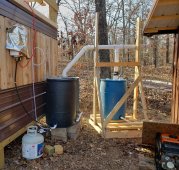I'm not sure how well this idea would work, if at all, but I'd like to get input from you guys. I'm trying to create an extremely affordable rainwater collector for areas with little precipitation, and enough land. While this idea may be affordable, it does require a lot of labor.
My Rammed Earth Rainwater Collector Idea
The idea is to ram earth (not stabilized), creating a sloped rainwater collector surface with rammed walls around the perimeter to reject some dust and debris. After the collector is rammed, coat the surface with Henry's 887 Tropicool 100% Silicone Reflective Roof Coating. This coating is said to be 100 percent waterproof, "LIFETIME WARRANTY - One coat protects against extreme weather," and requires just one coat. I imagine you could maintain with more coats to specific areas needing to be touched-up.
Its location (away from floods) and ability to shed water away from the perimeter of the collector is important, I imagine, to avoid water eroding away the collector.
I have no idea if the coating would adhere to the rammed earth, or if this idea is just terrible. Any thoughts?
My Rammed Earth Rainwater Collector Idea
The idea is to ram earth (not stabilized), creating a sloped rainwater collector surface with rammed walls around the perimeter to reject some dust and debris. After the collector is rammed, coat the surface with Henry's 887 Tropicool 100% Silicone Reflective Roof Coating. This coating is said to be 100 percent waterproof, "LIFETIME WARRANTY - One coat protects against extreme weather," and requires just one coat. I imagine you could maintain with more coats to specific areas needing to be touched-up.
Its location (away from floods) and ability to shed water away from the perimeter of the collector is important, I imagine, to avoid water eroding away the collector.
I have no idea if the coating would adhere to the rammed earth, or if this idea is just terrible. Any thoughts?
Last edited:



